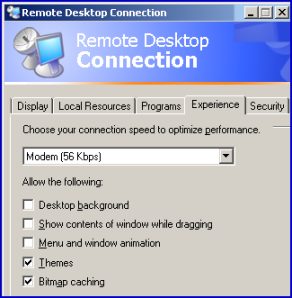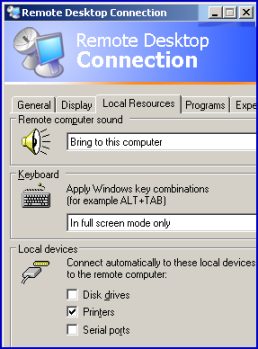Introduction to Terminal Services – Client Connections
If you have already used Vista or XP’s Remote Desktop then you will have an appreciation of the style and power of the Terminal Services interface. Windows Server 2003 has a service called Terminal Services, which provides the XP experience to Windows 95 and even web clients. Just to be clear on Microsoft’s terminology, the Terminal Services Client is called Remote Desktop Connection (RDC). Furthermore, under the covers, the RDC client connects to its server using RDP (Remote Desktop Protocol).
Topics for Terminal Services Client Connections
- Remote Desktop Connection Options
- Color Display
- Programs
- Local Devices
- Experience
- Security Tab
- Windows 7 Remote Desktop Connection
- Summary of Remote Desktop
Remote Desktop Connection Options
To configure the terminal services session on the local machine, you need to launch the Remote Desktop client. On an XP machine click Start, All Programs, Accessories, and Communications.
Note 1: If you want to be flashy, click Start then Run, type mstsc.
Note 2: I also recommend you try Remote Desktop Web Connection
For other host operating systems, locate the folder where the administrator installed the RDC client. If you are that administrator, then you can install the client from Microsoft’s XP CD. Note you don’t need to install the whole XP operating system, just seek out the ‘Additional Tasks’ menu. Still stuck for a client? Go to Microsoft’s site and search for ‘download remote desktop’.
You will enjoy configuring the client by pressing the aptly named Options button, which you find on the Remote Desktop Connection logon interface. (See blue ring on diagram above.)
If you are going to connect to the Terminal Server regularly, click on the General Tab and type in the username and password. I love the box which enables Windows to remember my password. The only slight difficulty is the ‘Browse for server button’, however if you remember to type the name of the computer in the first dialog box, there is no problem finding the Windows 2003 or 2008 Server.
Kiwi Syslog Server 
Free Utility to Analyze Your Network Messages
Syslog messages contain useful information for troubleshooting network problems. When something goes wrong then surely there will be an error message in the syslog datagram – if only we can find that record and interpret the event.
Here is a utility to capture and analyze network messages. The Kiwi Syslog Server filters messages and creates advanced alerts. View your syslog data via web access.
Download your free download of Kiwi Syslog Server
 Color Display
Color Display
Microsoft has corrected the biggest problem in previous editions of terminal services, namely improved Color resolution. The Colors menu (opposite) shows how easy it is to choose the highest resolution that your client’s monitor supports. The range now goes from 256 right up to True Color (24 bit).
Microsoft provide a slider to adjust the remote desktop size, however I find it just as easy to use the normal windows controls once I have connected to the server.
Programs Tab
Remote Desktop connection also has a Programs tab. While I have not found a ‘killer’ use for this button, if you can think of an application that would help users, then Microsoft has provided the interface for you to launch it on the Vista or XP client.
In some ways this Programs tab is a substitute to the Startup menu found on normal XP clients.
Local Resources
On the Remote Desktop Options, the Local Resources tab reveals many of the most useful new features. In previous generations of Terminal Services it frustrated me that I could not Alt + Tab, well now I can execute this trusty keyboard combination.
Local Devices give users a choice of server or local machine for disk drives, printers and COM ports. However, there will always be an element of confusion as to whether a disk, COM port or printer is on the server or on the client. Users need no invitation to ‘lose data’. The danger is that they may think they are saving files locally, whereas the files are actually saved on the server. To conclude, you may wish to control local devices via Terminal Services Group Policies.
There are enough Terminal Services options to warrant producing a short training document / web page or even a short course. If you decide to go down this user training route then looking after files would be a central element in your best practice documents.
There is one more decision with local resources, and that concerns sound. If it were me, then I would want to control the audio setting, ‘Bring to this computer’ setting. However, if you were setting up a Terminal server kiosk, then the option to ‘Leave sound on the server’ would be preferable.
See Windows 8 Remote Desktop Connection.
Guy Recommends: A Free Trial of the Network Performance Monitor (NPM) v12
v12
SolarWinds’ Network Performance Monitor will help you discover what’s happening on your network. This utility will also guide you through troubleshooting; the dashboard will indicate whether the root cause is a broken link, faulty equipment or resource overload.
Perhaps the NPM’s best feature is the way it suggests solutions to network problems. Its second best feature is the ability to monitor the health of individual VMware virtual machines. If you are interested in troubleshooting, and creating network maps, then I recommend that you give this Network Performance Monitor a try.
Download your free trial of SolarWinds Network Performance Monitor.
Customizing the Remote Desktop Experience.
The Experience tab is gives you a sense of power and control. Your first decision is to select the most appropriate connection speed. If you need low bandwidth connections, then you can remove the ticks next to Bitmap caching and Themes.
Your first decision is to select the most appropriate connection speed. If you need low bandwidth connections, then you can remove the ticks next to Bitmap caching and Themes.
Try experimenting with ticking, ‘Show contents of window while dragging’ and ‘Menu and window animation’. If you are going to spend time with the a Terminal Server connection, then its worth spending a few minutes investigating the variety of setting available.
Security Tab
Here is a surprise. For once Microsoft’s Security tab is not about permissions, but about authenticating the Server to the client. The idea is twofold. Firstly, to ensure that the users on the client are connecting to a know server and not a phishing or fake server. Secondly, to ensure that the connection, once established is secure.
Technically, security relies on Transport Layer Security (TLS) 1.0; therefore, to provide this level of authentication you must apply SP1 to the Windows 2003 Server. High security companies rave about the new security, whereas the rest say, ‘One more setting to go wrong, we will leave this tab alone’. Guy says, ‘The more security you have the more work for you the administrator.
See also SolarWinds free Real-time Netflow Analyser »
Summary of Remote Desktop Client
The Remote Desktop Options button opens the door to 6 more tabs where you can control every aspect of the client’s Terminal Services (XP) experience. If I could single out two settings to check, make sure you get high 24 bit color, and decide when you save files, if its to the local machine or the server.
If you like this page then please share it with your friends



